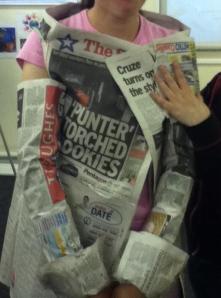As #ELTchat were just discussing ‘Teaching Dyslexic Students‘ and November is the month for National Dyslexia Week here in the UK , I have decided to share my experiences on the subject both as a literacy tutor and as a dyslexic.
*#ELTchat stands for English Language Teacher Chat. The chat happens every Weds at 9pm on Twitter and more information about this can be found on ELTchats website.
As #ELTchat discussed there are a number of different ways that an educator can adapt their practice in order to enhance the learning of dyslexic students. Over my next few blog posts I will discuss some of the alterations that you can make and how these could affect your students. My opinions are based on my personal experience as a dyslexic and my professional experience as a literacy tutor.
Use of Colour
SueAnn tweeted:
| SueAnnan |
11:06 PM |
We had a dyslexic student recently who was greatly helped by using coloured acetates over her work. #ELTchat |
Coloured backgrounds can greatly help dyslexics as the colour helps the text to stay in one place thus preventing it from swimming around on the page. As well as using overlays coloured paper and coloured ppt backgrounds can also have a positive effect. Cream or pastel coloured backgrounds are the most effective colours for general use like card match activities and ppts, however, dyslexics are very much individuals so you need to find out what colours works best for your learners and then print their worksheets/handouts out on these colours.
Scoptopic sensitivity (colour sensitivity) doesn’t only effect dyslexics. 1 in 10 people in the UK are dyslexic where as 2 in 10 people suffer from scotoptic sensitivity. Therefore changing the colour of your resources could have a great impact on your students learning. Scoptopic sensitivity is rarely diagnosed in people without dyslexia therefore there are a lot of suffers who don’t know that they have the condition. I had suffered with migraines since starting primary school and had regularly been to the opticians, however scotopic sensitivity was never mentioned until I was diagnosed with dyslexia at the age of 26. Despite suffering from constant migraines throughout my compulsory education now I have tinted glasses and use green paper I rarely suffer from migraines.
Audio Recordings
| cerirhiannon |
11:10 PM |
#eltchat using audio /voice recording for notes can help |
As cerirhiannon mentioned audio and voice recordings can help dyslexics considerably with note taking. Dyslexics generally have weak short-term memories so copying notes from the board or from lectures is extremely difficult as by the time they have finished noting down part one down they have missed part two and the tutor is on to part three. Since being diagnosed I have started recording all of my lectures and have a noticeable improvement in my knowledge retention and the quality of my work. I am able to listen to the recordings over and over again until I have noted down all of the information I need. Then I can turn the information into mind maps to help retain the knowledge. A series of podcasts with lesson recordings may be a useful resource, espescially as many students may not have access to a dictaphone.
ELT Chat
Below is a short selection of the tweets from #eltchat.
| oHart |
11:17 PM |
RT @kalinagoenglish: As dyslexic learner – another thing that’s really hard are activities which require listening and writing at the same time #eltchat |
| cerirhiannon |
11:16 PM |
RT @kalinagoenglish: RT @reditho: – in truth, dyslexics r often high IQ 🙂 and visionary-out-of-box thinkers #eltchat (wink) > 🙂 |
| vickyloras |
11:08 PM |
We worked with a specialist in Greece-1st thing he told us, no clutter for sts on desk,board, nowhere #ELTChat |
| reditho |
11:11 PM |
RT @Marisa_C: Sharing a dyslexia checklist which I often give to my trainees http://t.co/EWLZ6vnh #eltchat #dyslexia |
| shaznosel |
11:26 PM |
@Marisa_C #eltchat cloze activities if the words needed are written in a box to guide the student – spelling wise..depends on ss |
| Redsra |
11:42 PM |
RT @TES_SEN: Lots of support for managing dyslexia in the classroom on the TES – http://t.co/burG6RDP #eltchat |
| rliberni |
11:52 PM |
RT @antoniaclare: @reditho I think it’s important to look at content, point out what is good, but note areas that need sep work to focus on #eltchat |


















